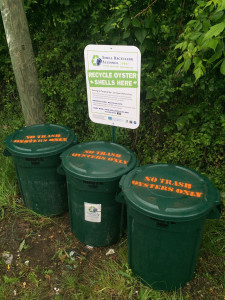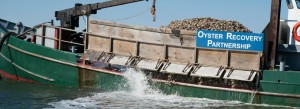
Public shell collection site in Baltimore City (Sission Street)
Oyster Recovery Partnership offers public drop sites in Maryland and Virginia
Chesapeake Bay oyster season is typically synonymous with crowded raw bars and oyster festivals galore. With restaurants closed or operating at limited capacity and events non-existent, this year is different. Many oysters are bypassing shell recycling businesses and going directly to the hands of the at-home shucker, especially during the holiday season. The Oyster Recovery Partnership (ORP) reminds area residents to save and recycle their shell at one of the more than 70 public collection sites throughout the region.
“Oyster shell is the best material for getting young oysters into the Chesapeake Bay, making it the single most important resource to the oyster restoration process,” said Tommy Price, ORP’s Shell Recycling Alliance operations manager. “Right now, we’re experiencing a major shell shortage and we’re calling on the public to help us close that gap.”
ORP’s Shell Recycling Alliance collects free of charge from collection sites and hundreds of seafood businesses throughout the Mid-Atlantic, making it the largest oyster shell recycling network in the nation. Up until 2020, ORP was seeing increased collection totals every year. This year, the organization has recycled less than half of average projections: approximately 14,000 bushels from January to November 2020, compared to 31,000 bushels over the same time period in 2019.
This drop in shell is also indicative of declining in oyster sales. With limited places to sell their product, harvesters have thousands of market size Chesapeake Bay oysters at the ready. Recognizing this need, ORP has spent the past several months encouraging residents to enjoy the Bay’s bounty at home, promoting local oysters, hosting virtual shucking workshops, and sharing how consumers can support the seafood and restaurant industry during this time with a comprehensive guide, located here.
“We encourage oyster lovers to come together to support the Chesapeake Bay seafood industry during a time when they need it most,” said Price. “Buy local seafood from markets and restaurants, enjoy oysters at home and recycle your shell. It’s a win–win–win.”
Natural oyster shell is vital to a healthy oyster population because it is the preferred material onto which oyster larvae attach themselves and grow. In fact, every half shell can host up to 10 spat, or baby oysters. Once collected, the oyster shell is aged outside for one year, washed, and set with spat by the University of Maryland Center for Environmental Science Horn Point Laboratory Oyster Hatchery in Cambridge.
 ORP works with its restoration partners through Spring and Summer to deploy the spat-covered shells onto local oyster reefs, making them larger, denser, and taller, with the ultimate goal of encouraging continued spawning. Oysters play a vital role in improving Chesapeake Bay health by filtering excess nutrients from the water and creating reef habitat for a multitude of marine life. Over the past two decades, the Oyster Recovery Partnership has planted approximately 8.5 billion oysters on 2,500 underwater acres while recycling 225,000 bushels of shell.
ORP works with its restoration partners through Spring and Summer to deploy the spat-covered shells onto local oyster reefs, making them larger, denser, and taller, with the ultimate goal of encouraging continued spawning. Oysters play a vital role in improving Chesapeake Bay health by filtering excess nutrients from the water and creating reef habitat for a multitude of marine life. Over the past two decades, the Oyster Recovery Partnership has planted approximately 8.5 billion oysters on 2,500 underwater acres while recycling 225,000 bushels of shell.
Media Contact: Karis King, ORP Events Manager | [email protected]
